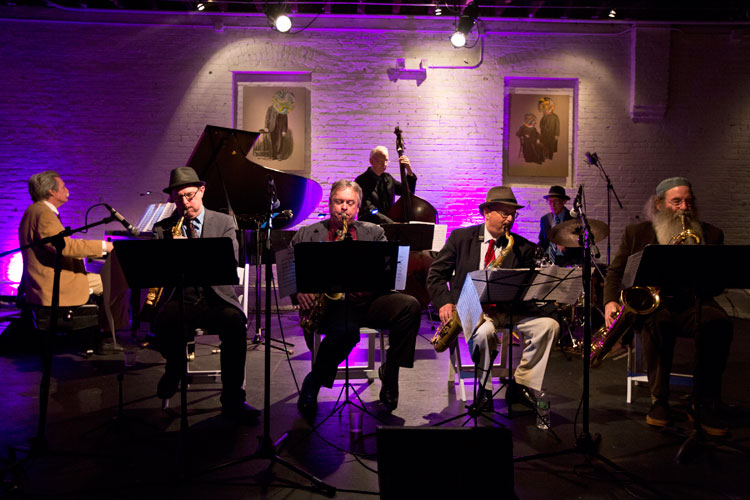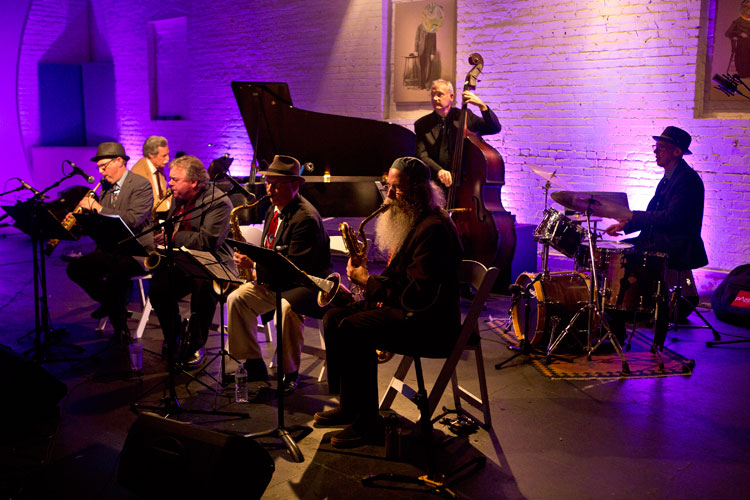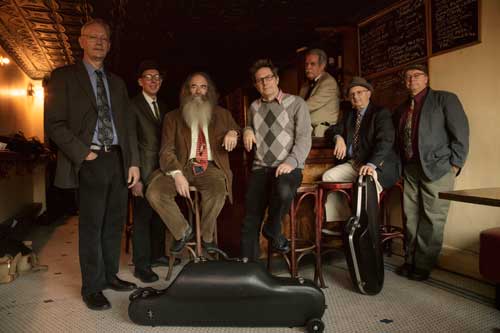In April 2017,
|
| Been Up So Long It Looks Like Down to Me: The Micros Play the Blues Track Listing: 1. Cat Toys (4:33) 2. Blues Cubistico (2:47) 3. Dark Blue (6:34) 4. Don’t Mind If I Do (4:25) 5. Migraine Blues (for Wendlyn Alter) (4:50) 6. PJ in the 60s (6:21) 7. When It’s Getting Dark (4:34) 8. Simple-Minded Blues (5:43) 9. After You, Joel (2:28) 10. 12 Angry Birds (4:26) 11. Quizzical (5:51) 12. Silent Night (6:21) 13. I’ve Got a Right to Cry (3:16) |
The Microscopic Septet
Phillip Johnston - soprano saxophone
Don Davis - alto saxophone
Mike Hashim - tenor saxophone
Dave Sewelson - baritone saxophone, vocals (on #13)
Joel Forrester - piano
Dave Hofstra - bass
Richard Dworkin - drums
Tracks 1, 2, 4, 7, 10, 11 by Phillip Johnston © Jedible Music (BMI).
Tracks 3, 5, 6, 8, 9, 12, by Joel Forrester © Way Real Music (BMI).
Track 13 by Joe Liggins © Nanohits Inc (BMI).
Recorded May 24–25, 2016 at Tedesco Studios.
Engineered, mixed and mastered by Jon Rosenberg.
Assistant engineer: Tom Tedesco
Cover Art: Kaz
Photography: Greg Cristman
Graphic Design: Bill Ellsworth
Produced by Phillip Johnston.
Thanks to Kickstarter.com; Roberto’s Woodwinds/Michiko Rehearsal Studios; Jon Rosenberg; Tom Tedesco; Kaz; Lee Roth; and Steve, Joyce and Javier at Cuneiform Records.
What happens when you put the blues under a microscope? When the lens is wielded by the incisive deconstructivists of the Microscopic Septet, the musical odyssey traverses territory that’s disarmingly strange, pleasingly familiar and consistently revelatory. It takes an unusual band to make news out of the blues, and the Micros deliver a gripping investigation of the form on Been Up So Long It Looks Like Down to Me: The Micros Play the Blues.
The new album continues the Micros’ brilliant resurgence, storming back into action in 2006 after a 14-year hiatus to reissue its old and release new recordings on Cuneiform Records. Since then, the radically old-school new-context combo has continued to evolve, extending its reputation as one of New York’s most ardently inventive ensembles of the 1980s to being recognized as one of the 21st Century’s most accomplished, informed, and iconoclastic jazz groups. Throughout, they maintained their distinctive modus operandi: exploring and unraveling jazz’s myriad strains, the Micros re-weave a century of jazz into modern tunes of equal popular and critical appeal. Since 2006, they’ve collaborated with known cartoonists and/or illustrators for their album art, including Art Spiegelman, New Yorker cover artist Barry Blitt, Australian graphic artists Antonia Pesenti and Keith Lobue. The Micros Play the Blues builds on the band’s longstanding love of that most basic and profound musical form, bringing the same reverently irreverent and insistently playful approach to the blues that has marked the Micros’ music from the beginning. This album’s cover art is by Kaz, best known for his comic Underworld and his writing for SpongeBob SquarePants.
“We’ve always loved the blues,” says soprano saxophonist/composer Phillip Johnston, who co-founded the Micros with pianist/composer Joel Forrester. “We’ve recorded blues on every record we’ve made. I don’t think there’s anything more sophisticated than the blues. Our only fear was that the tunes would sound too much alike, and we made a conscious effort to cast a wide net. Every tune sounds different.”

[The Microscopic Septet | photo credit: Greg Cristman]
Along with the co-founders, the seven-piece ensemble features largely the same cast of improvisers with which it emerged from Manhattan’s wild and wooly Downtown scene in 1980. Drummer Richard Dworkin, baritone saxophonist David Sewelson, bassist David Hofstra, and altoist Don Davis (who replaced John Zorn in 1981) have all been along for almost the entire Microscopic sojourn, while Mike Hashim came on board for the 2006 reboot, taking over the tenor sax chair from Paul Shapiro (the only Micros spot that’s seen real turnover).
As on previous projects, Johnston and Forrester provide the lion’s share of tunes and arrangements, and they both dig deep into their voluminous catalogs for interesting material. The album opens with Johnston’s late-night cinematic joy ride “Cat Toys,” a piece inspired by Hammond B-3-driven soul jazz and originally written for the credit sequence of a short film about a San Fernando Valley-dwelling space alien with a taste for felines (seriously).
Johnston’s cascading 14-bar “Blues Cubistico” features some brawny baritone sax work by Dave Sewelson, while his cheerful soprano sax intro on “Don’t Mind If I Do” sounds like a rent party picking up steam around 11 pm on a Saturday night. Johnston repurposed “When It’s Getting Dark” from his rock band The Public Servants (which featured guitarist Bill Horvitz, vocalist Shelley Hirsch, and several Micros), and the tune retains its predatory rock ‘n’ rhythm vibe.
“12 Angry Birds” delivers a triumphant verdict on the enduring power of Ellingtonian cadences, as the piece sounds like a forgotten number from the 1927 session on Victor, complete with a deliciously squally soprano sax solo. Long time Micros fans will be delighted to hear tunes that have been in the repertoire for decades but never recorded, like “I’ve Got a Right to Cry.” While not actually a blues, the piece was a 1950 hit for the great Los Angeles R&B band Joe Liggins and the Honeydrippers.
“That’s a tune we did from the very beginning,” Johnston says. “We’ve always played tunes by other people, but didn’t record a lot of them. We have a number of vocal tunes, and we never recorded any of those and I love Dave’s singing on this. ‘I’ve Got a Right to Cry’ isn’t a blues, but it fit in so well with the rest of the album.”
Forrester contributes about half of the album’s tunes, including the sensually slow drag “Dark Blue,” a feature for bassist David Hofstra (who’s walking figure guides the band even when he sits out). The pianist offers a propulsive jazz march with “Migraine Blues,” and designs a deliciously woozy and off-kilter jaunt with “Simple-Minded Blues.” In another utterly surprisingly but entirely sensible move, Forrester turns the carol “Silent Night” into a convincing blues that captures the angst too many people feel as the holidays approach. In fact, Forrester staked a claim to the song at a Christmas party where he “took it into my head to derange Silent Night, which has always struck me as close to the blues,” he says. “During the improvisation the chords were really stripped down. I wanted people to take a more primal approach.”
Whatever the music’s origin or vintage, the Micros put their indelible stamp on each piece, with loose and limber arrangements combining stellar craftsmanship and extroverted improvisation. The blues provide another avenue for the band to explore jazz history while forging a sound quite unlike any other ensemble.
Simultaneously embracing the past and the future makes perfect sense when you consider the fraught time and place that gave birth to the Microscopic Septet. In the early 1980s the New York jazz scene was bitterly divided. Irony-laced Downtown players explored new territory drawing on free jazz, rock, funk and later, Balkan influences. At the same time, other young players, following in the footsteps of trumpeter Wynton Marsalis, defined mainstream jazz by looking backwards to 1950s hard bop and 1960s post bop. Rejecting allegiance to any particular camp or faction, the Micros forged their own path with an ethos succinctly summed up by Johnston: “Break all the rules and respect all the saints.”
Embracing jazz’s populist legacy, the Micros brought Uptown jazz back Downtown, where they made a compelling case that swing could look forward as well as backward. The band adopted a name that playfully alluded to its orchestral palette. As Johnston explained at the time, “The instrumentation is enough to give us a big range of colors and work compositionally in a more expansive way.” But the name also described their compositions, which often distilled the essence of an era within an artfully executed voicing. “Through its command of idiomatic detail,” opined The New York Times, “the group summons the sound of an Ellington orchestra, or the feel of a 50’s rhythm-and-blues band, with a few well-chosen phrases and sonorities.”

[The Microscopic Septet | photo credit: Greg Cristman]
The band was built upon the felicitous partnership of Johnston and Forrester, who met in the early 70s and bonded over shared musical aesthetics, humor, and similarly skewed worldviews. Eager to break away from the jazz straightjacket of head-solo-head formats, they honed extended, lapidary jazz compositions that segued gracefully between different themes in a single piece, hearkening forward to forms employed by Sun Ra, Duke Ellington and Jelly Roll Morton. The music drew on the entire history of jazz, as well as polkas, tangos, antic cartoon themes, klezmer, and new wave rock. No matter how eclectic their influences, the Micros always hewed to the band’s prime directive. “It’s gotta swing, whether its Latin or R&B or straight-ahead blowing,” Johnston says. “That’s the foundation of what we do.”
Prolific composers, Forrester and Johnston had created a songbook of nearly 200 tunes by the time the band called it a day in 1992. During the Micros’ first incarnation they only got around to recording 34 pieces on four albums, which were all released on small labels to an impressive array of critical acclaim. The band’s 1983 debut LP, Take the Z Train, came out on Press Records and featured cover art by San Francisco artist Bill Paradise. “It is as if the entire history of improvisatory music is on parade,” Cadence exclaimed. A live album, Let’s Flip!, followed in 1985, recorded in Rotterdam and released by Dutch label Osmosis Records, which also released 1986’s Off Beat Glory. Stash put out Beauty Based on Science in 1988 with liner notes by “New York School” poet, Ron Padgett, cover art by painter Bob Tuska, and cartoons by Collin Kellogg.
In keeping with the band’s perverse ways, they were reaching a vast new audience when they disbanded. Forrester’s theme song for the long-running NPR show Fresh Air with Terry Gross, which continues to be heard by millions of public radio listeners every day, was introduced in 1990. Cuneiform’s decision to reissue the band’s albums on two double albums in 2006, Seven Men in Neckties and Surrealistic Swing, introduced the band to a generation of jazz fans who came of age in the ensuing years. Featuring striking CD artwork by Pulitzer Prize-winning New York cartoonist Art Spiegelman, (creator of the graphic novel Maus), the History of the Micros albums contain all the music from the four original albums and 11 previously unreleased tracks.
The reception was so positive that the band reunited for a European tour, which led to the Micros returning to the studio for 2008’s Lobster Leaps In, an acclaimed Cuneiform album featuring beloved tunes and overlooked gems from the band’s original book. They followed up two years later with the masterful Monk album Friday the Thirteenth: The Micros Play Monk, illustrated with Barry Blitt’s artwork, and made another major leap back into the future with 2014’s acclaimed Manhattan Moonrise, an album that shows the Micros are still a cutting-edge ensemble forging boldly into old territory. “Neither Phillip nor I want to settle into any definite harmonic groove,” Forrester says “Coming up with an array of the blues is just a means taking the Micros into the next century.”
PROMOTIONAL TRACK //
If you'd like to share music from this release, please feel free to use the following track:
 "Don’t Mind If I Do" stream: @SoundCloud / @Bandcamp / @YouTube
"Don’t Mind If I Do" stream: @SoundCloud / @Bandcamp / @YouTubePURCHASE LINKS //
ITUNES - AMAZON - BANDCAMP - WAYSIDE MUSIC
ARTIST WEB SITES //
www.microscopicseptet.com - www.facebook.com/MicroscopicSeptet - www.cuneiformrecords.com
// THE MICROSCOPIC SEPTET - TOUR DATES: 2017 //
| April 2 | USA | Small's Jazz Club 183 West 10th St NYC, NY 10014 |
7:30pm |
| April 6 | USA | The Falcon 1348 Route 9W Marlboro, NY 12542 |
7:00pm |



No comments:
Post a Comment